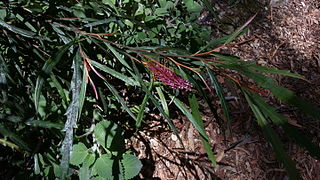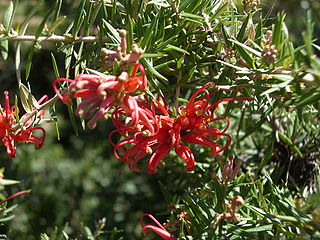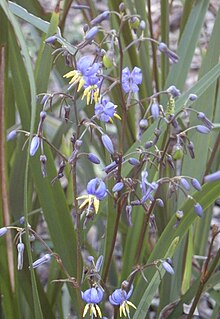
Grevillea longifolia, the fern-leaf spider flower, is a plant of the family Proteaceae, formerly known as Grevillea aspleniifolia. Commonly growing in the Sydney basin of central New South Wales, Australia Grevillea longifolia is recognizable by its deep red "toothbrush" flowers which appear in spring, and narrow, sawtoothed leaves. It is fairly readily grown in gardens.

Bulbine bulbosa, commonly known as bulbine lily, is a flowering plant in the genus Bulbine. It is endemic to Australia.

Blandfordia, commonly known as Christmas bells, is a genus of four species of flowering plants native to eastern Australia. Christmas bells are tufted, perennial herbs with narrow, linear leaves and up to twenty large, drooping, cylindrical or bell-shaped flowers.

Dianella is a monocot genus of flowering plants. They are commonly called flax lilies.

Grevillea juniperina, commonly known as juniper- or juniper-leaf grevillea or prickly spider-flower, is a plant of the family Proteaceae native to eastern New South Wales and south-eastern Queensland in Australia. Scottish botanist Robert Brown described the species in 1810, and seven subspecies are recognised. One subspecies, G. j. juniperina, is restricted to Western Sydney and environs and is threatened by loss of habitat and housing development.

Dianella caerulea, commonly known as the blue flax-lily, blueberry lily, or paroo lily, is a perennial herb of the family Asphodelaceae, subfamily Hemerocallidoideae, found across the eastern states of Australia and Tasmania. It is a herbaceous strappy perennial plant to a metre high, with dark green blade-like leaves to 70 cm long. Blue flowers in spring and summer are followed by indigo-coloured berries. It adapts readily to cultivation and is commonly seen in Australian gardens and amenities plantings.

Stypandra is a small genus of rhizomatous perennials in the family Asphodelaceae, subfamily Hemerocallidoideae. They are native to Australia and New Caledonia.

Agapanthus praecox is a popular garden plant around the world, especially in Mediterranean climates. It is native of Natal and Cape of Good Hope in South Africa, local names include agapant, bloulelie, isicakathi and ubani. Most of the cultivated plants of the genus Agapanthus are hybrids or cultivars of this species. It is divided into three subspecies: subsp.praecox, subsp. orientalis and subsp. minimus.

Caesia is a genus of herbs in the family Asphodelaceae, subfamily Hemerocallidoideae, native to Australia, New Guinea, Madagascar and Southern Africa. The mostly 3-lobed seed capsules contain rounded black seeds. The genus was named in honour of Federico Cesi (1585-1630), an Italian scientist.
- Caesia alpina Hook.f. - alpine grass-lily - New South Wales, Tasmania, Victoria
- Caesia calliantha R.J.F.Hend. - blue grass-lily - New South Wales, Tasmania, Victoria, South Australia
- Caesia capensis(Bolus) Oberm. - Cape Province of South Africa
- Caesia chlorantha F.Muell. - New South Wales, Queensland, Western Australia
- Caesia micrantha Lindl. - New South Wales, Tasmania, Victoria, South Australia, Western Australia, Queensland
- Caesia occidentalis R.Br. - Western Australia
- Caesia parviflora R.Br. - pale grass-lily - Queensland, New South Wales, Tasmania, Victoria, South Australia, Western Australia
- †Caesia rigidifolia F.Muell. - Queen Victoria Springs in Western Australia but extinct. Last recorded near Zanthus in 1875.
- Caesia sabulosaBoatwr. & J.C.Manning - Cape Province
- Caesia setifera Baker - Queensland, Western Australia, Northern Territory, New Guinea
- Caesia subulataBaker - Madagascar
- Caesia viscida Keighery - Western Australia

Stypandra glauca is a species of rhizomatous perennial plant. It is widespread across southern areas of Australia, where it is informally known as the nodding blue lily or blind grass.
Austrodanthonia caespitosa, known by various common names including common wallaby-grass, ringed wallaby-grass, and white-top, is a species of grass native to southern parts of Australia.

Laxmannia is a genus of tufted perennial herbs in the family Asparagaceae, subfamily Lomandroideae, that are endemic to Australia.

Mount Banda Banda, a mountain of the Mid North Coast region of New South Wales, Australia, is situated 320 kilometres (200 mi) from Sydney within the Willi Willi National Park. Banda Banda can be seen on the north western horizon from Port Macquarie. And seen on the south western horizon 39km from the town of Kempsey. At 1,258 metres (4,127 ft) AHD it is the highest mountain in the region.

Thelionema is a small genus of tufted perennials in the family Asphodelaceae, subfamily Hemerocallidoideae. All three species, which were previously placed in the genus Stypandra, are native to Australia. These are:

Thelymitra ixioides, known as the spotted sun orchid or dotted sun orchid, is a species of orchid that is native to southern and eastern Australia and to New Zealand. It has a single long, thin, dark green leaf and up to ten flowers which occur in a range of colours, most commonly blue to purple but usually with small, dark blue spots. It is a variable species, similar to T. juncifolia which has smaller flowers.

Blue lily may refer to the following plant species:

Calectasia narragara, commonly known as a blue tinsel lily or star of Bethlehem, is a plant in the family Dasypogonaceae growing as a tufted rhizomatous herb. It is endemic to the south-west of Western Australia and common in most of its range.
Calectasia palustris, commonly known as a blue tinsel lily or swamp tinsel lily is a plant in the family Dasypogonaceae growing as a perennial, tufted herb with stilt roots. It is an uncommon species, endemic and restricted to a few areas in the south-west of Western Australia. It is similar to the other species of Calectasia and has only been recognised as a separate species since a review of the genus in 2001.

Thelionema grande, the tufted granite lily is a species of perennial herb, native to Australia. Growing up to 125 cm high, the lily-like flowers are blue or rarely white with yellow stamens. The species occurs in Queensland and New South Wales. Found on sandy soils near granite outcrops. From altitutes over 800 metres in the northern ranges of New South Wales and adjacent areas in Queensland. First known as Stypandra grandis. The species was transferred to a new genus, Thelionema, in 1985.














